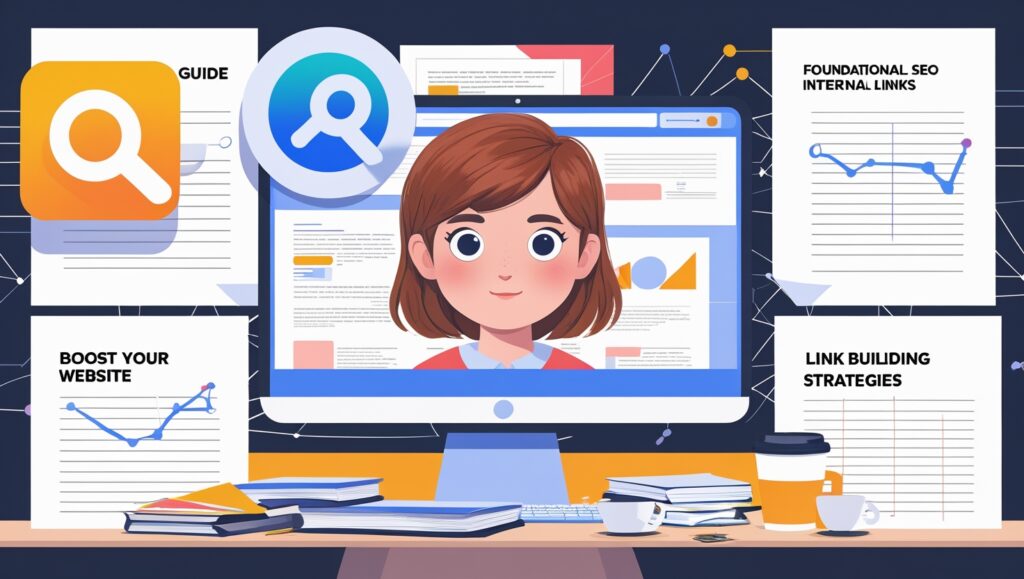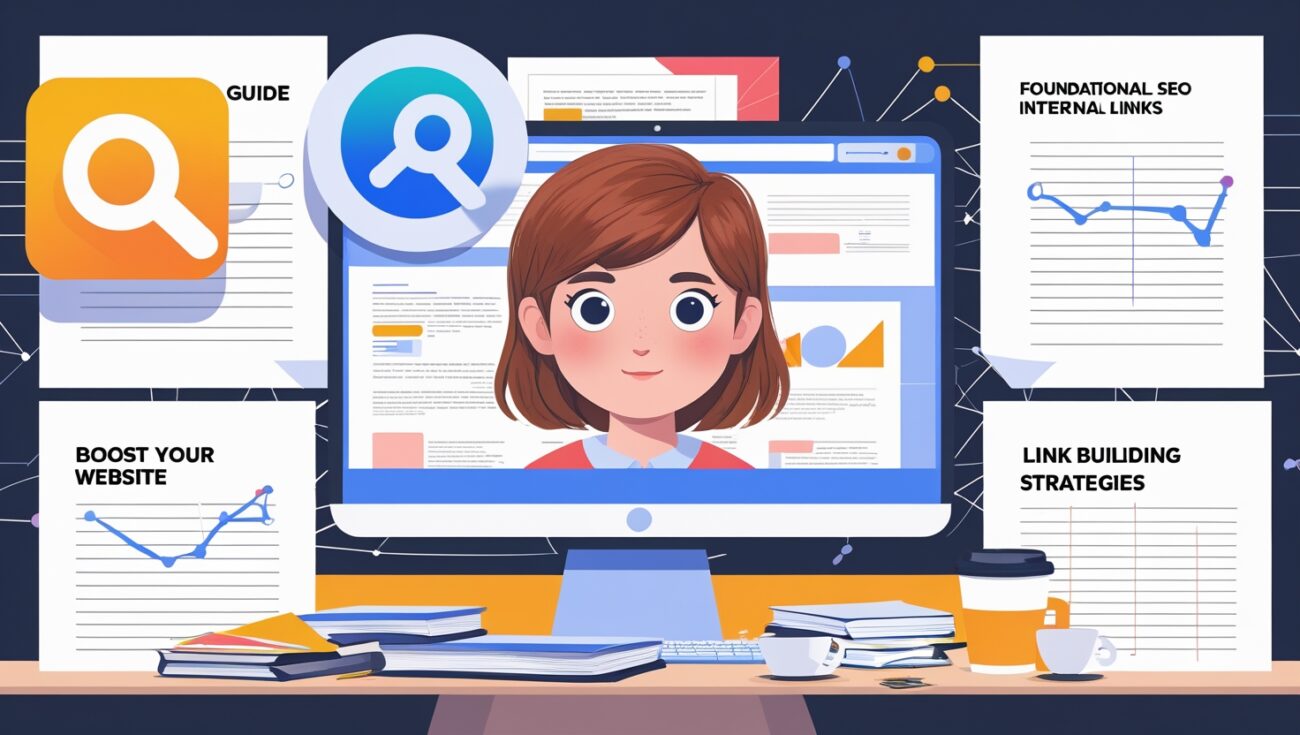The Foundational SEO Power of Internal Links: A Beginner’s Guide
When I first started in SEO, I felt overwhelmed. There are so many acronyms, rules, and factors to consider that it can feel impossible to know where to begin. But I’ve learned that you don’t need to be an expert to start making a real impact. The most powerful, and often easiest, place to start is with a foundational SEO tactic that you have complete control over: internal linking.

Table of Contents
Think of your website like a book. Your internal links are your table of contents, your index, and the “see also” notes that guide a reader from one chapter to another. They are the pathways that connect all of your valuable content. Mastering this single concept is the first and most important step to building a website that ranks well. Let me walk you through why internal linking is the ultimate foundational SEO skill for any beginner.
What Exactly is an Internal Link?
An internal link is simply a hyperlink that connects one page on your website to another page on your same website. It’s a click-able piece of text that takes a visitor and a search engine bot from one piece of your content to another.
The Three Core SEO Powers of Internal Links
While it seems simple, an internal link does a lot of heavy lifting for your website’s SEO. Here are its three core powers:
Power 1: Improved Crawlability
Search engine bots (like Googlebot) crawl your website by following links. If a page on your site isn’t linked to by any other page, the bot might never find it. By adding a simple internal link, you are creating a new pathway for the bot, helping it to discover and index all of your content. More links mean more discovery.
Power 2: Distributing Authority (Link Equity)
Think of your website’s authority as a form of trust. Some of your pages (like your homepage or a popular article) have more trust than others. When you link from a high-trust page to a lower-trust page, you are passing on some of that valuable authority, often called link equity. This single link can give a new or struggling page the boost it needs to start ranking.
Power 3: Defining Site Structure
Every internal link helps to create a clear structure for your website. By linking related articles together, you are helping search engines understand which pages are most important and what your website’s main topics are. This logical organization is a foundational signal to Google about your site’s quality and relevance.
A Simple Action Plan for Beginners
Step 1: Link Your New Content
This is the most basic and important step. When you publish a new article, go back and find 3-5 existing, relevant articles and add a link to your new content. This immediately makes the new article discoverable and gives it a powerful SEO boost.
Step 2: Use Descriptive Anchor Text
The anchor text is the visible, clickable text of your link. Instead of using a generic phrase like “click here,” use a descriptive phrase that tells the user and the search engine what the destination page is about. For example, linking to a page about “hiking trails” with the anchor text “learn more about the best hiking trails” is far more effective.
Step 3: Fix Broken & Orphaned Pages
A website with a messy internal link profile is full of “dead ends.” These include broken links that lead to nowhere and orphaned pages that have no incoming links. This hurts your SEO and frustrates users. Manually finding these issues is a pain, but a good tool makes it easy. I highly recommend using Linkbot to easily find all of your broken and orphaned pages.
The Role of Automation for Beginners
Even for a small website, manually managing all of your internal links can get confusing. How do you find every relevant linking opportunity? How do you know if you have an orphaned page? Automated internal linking software can analyze your site and provide you with a prioritized, actionable list of links to create. It’s the best way to get it right from the beginning without the hassle. With Linkbot, you can automate this crucial part of your SEO.
Conclusion: Build a Strong Foundation
Don’t let SEO overwhelm you. Start with the basics. By mastering internal linking, you are taking control of a foundational SEO element that can define your website’s success. It’s a low-cost, high-impact strategy that improves crawlability, distributes authority, and builds a strong site structure.
By taking a proactive approach to your internal linking, you are building a powerful, long-term asset that will help your content rank higher and attract more traffic. It’s the first step on the path to becoming an SEO expert. Start building your website’s strong foundation with Linkbot today.
Beyond the technical benefits, a clean internal linking structure is an essential part of providing a great user experience. A visitor who can easily navigate from one relevant, helpful article to another is much more likely to stay on your site, which naturally lowers your bounce rate. This intuitive navigation contributes directly to the “Experience” part of Google’s E-E-A-T framework, signaling that your website is a high-quality, user-friendly resource.
A simple way to think about link equity is like a trust signal. When a page has a lot of authority, it’s a bit like it has earned a lot of trust from Google. By adding an internal link from that page to a new one, you are giving the new page a “high-five” of trust. It’s a powerful vote of confidence that helps Google understand the new page is also a trustworthy and valuable piece of content.
A well-structured site also helps your pages rank for a wider variety of keywords, especially long-tail keywords. By linking all of your highly-relevant, specific articles to a central pillar page, you are effectively building a hub of authority that search engines can draw from. This concentrated relevance allows your entire site to capture traffic from more nuanced and less-competitive search queries.
The most important part of this foundational skill is building a consistent, logical linking habit. It’s not about doing a single audit and then forgetting about it. It’s about building a regular routine of finding relevant places to add links as you create new content. This small, consistent effort compounds over time, making your website stronger with every link.
It’s crucial for a beginner to understand that a simple category page is not the same as a clean site structure. A category page might group articles together, but it doesn’t create the powerful, intentional internal linking hierarchy that a well-structured site does. In a clean structure, links are carefully placed within the content itself, and the linking rules are strictly adhered to, creating a much stronger signal of topical relevance.
A dedicated internal link audit is a critical part of a beginner’s maintenance plan. It’s a non-negotiable part of a successful SEO strategy that helps you discover and fix a variety of issues, from broken links that lose valuable authority to orphaned pages that are completely invisible to search engines.
One of the greatest benefits of using an automated tool for your internal linking is the “to-do” list it provides. Instead of being overwhelmed by a massive site, a good tool will give you an actionable list of links to create. It transforms a monumental SEO task into a series of manageable steps that you can tackle in minutes.
The long-term ROI of a consistent internal linking plan is undeniable for a new website. It’s a foundational SEO tactic that you have full control over, and the benefits—from improved rankings and traffic to a better user experience—are long-lasting and continue to grow over time. The time invested in this strategy is paid back many times over.
I can say from personal experience that making this one change—from a passive blog to an active link-building tool—has been one of the most impactful changes I‘ve made to my own websites. It’s transformed my SEO efforts from a random guessing game into a proactive strategy that gives me a real sense of control over my site’s destiny.
With Google’s move to mobile-first indexing, having a logical and easily crawlable site structure is more important than ever. A well-built structure provides a clear path for search engine bots, no matter if they’re crawling from a desktop or mobile perspective. This makes your site more efficient to crawl and can contribute to better indexing and ranking performance.
The strategic value of a single internal link within a well-structured site is immense compared to a random one. A link from a category page to its supporting article is a powerful vote of confidence, signaling a strong topical connection. It’s this thoughtful placement of links that truly fuels the authority of your entire website.
Ultimately, mastering internal linking is not just an SEO tactic; it’s a fundamental part of building a high-quality, trustworthy website. By taking control of this foundational element, you’re building a digital asset that will work for you 24/7, helping you attract more visitors and grow your business.

